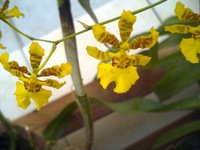Oncidium Golden Anniversary

Oncidium Golden Anniversary is a hybrid registered in January 1979 by Corbet. It’s parents are Oncidium spacelatum and Oncidium Sarcatum. This plant produces sprays up to a meter in length with multiple branches. Flowers are slightly bigger but lesser in quantity than the “Golden Shower” commonly seen at super-marts or florists in Singapore. It seems that the size and quantity are inversely proportional. Several plants come to mind which produces lesser but larger flowers compared to their cousins – Cattleya (bi- vs uni-foliate) and Phaleanopsis. The flowers lasts for about a month.
Oncidiums are sympodial and future flowering will depend on the success of new growths to maturity. They are believed to be the third most commonly cultivated orchid genus after Cattleya and Dendrobiums.
Oncidiums are commonly referred to as “Dancing Ladies” because the flowers resemble a figure of a lady swirling on the dance floor. Their flowers are mostly yellow & brown combination. This genus comprised of approximately 600 species. They are natives of South and Central America.
They are considered easy orchids to grow. Grow them in bright lights but out of direct mid-day sun to avoid scorching of their leaves. Water well year round but let media dry between watering. Fertilize lightly and consistently throughout. The ones commonly available here can flower year round as soon as the pseudobulbs mature. Ensure good air circulation.


